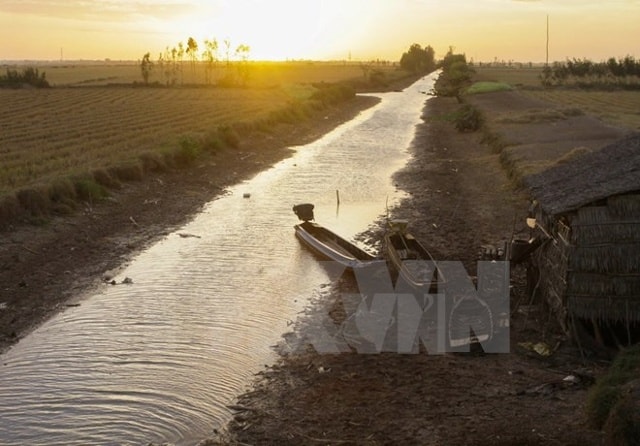All 13/13 provinces and cities in the Mekong Delta have been affected by saltwater intrusion.
According to Mr. Nguyen Huu Loc, an officer of the Mineral and Water Resources Division, Department of Natural Resources and Environment of An Giang province, recently saltwater has intruded into Thoai Son and Tri Ton districts, however the salinity concentration is still low, below 2 parts per thousand.
 |
| Ba Kep canal in Dai An 2 commune, Tran De district, Soc Trang province has been dry and salty since before Tet until now. |
Mr. Ky Quang Vinh, Chief of the Office of Climate Change of Can Tho City, said that on the Hau River, at Cai Cui Port, Cai Rang District, Can Tho City, from March 5th to now, the salinity concentration measured has always been above 2,000 mg/l. Specifically, on March 5th, the salinity concentration measured was 2,059 mg/l, on March 8th, it was 2,028 mg/l and since then, the salinity has always exceeded the drinking water threshold, above 2.5 mg/l.
Thus, by mid-March 2016, all 13/13 provinces and cities in the Mekong Delta region had been affected by saltwater intrusion; including many provinces with severe saltwater intrusion such as Ben Tre, Ca Mau, Kien Giang... In Ben Tre province alone, only 4 communes in Cho Lach district have not been affected by saltwater intrusion, all the remaining communes of this province have been affected by saltwater intrusion deep into the fields.
According to the Southern Institute of Water Resources Research, currently and in the near future, the hot weather will cause a large demand for fresh water for irrigation of agricultural production; at the same time, the evaporation rate is high, and the natural loss of fresh water is large. Due to the above factors, combined with high tides and strong winds, saltwater intrusion in the Mekong Delta has been, is and will be causing many disadvantages for production and water sources for daily life.
The Southern Institute of Water Resources Research forecasts that in some areas in the Mekong Delta from now until May 2016, when there are level 5 or 6 winds or higher, salinity will increase. If there is rain in May 2016 in the Mekong Delta and the Mekong River basin, salinity will decrease significantly compared to the forecast.
Specifically, from now until March 18, in areas 30-45km from the sea, fresh water will decrease significantly and there will be almost no possibility of getting fresh water from the river mouth; in areas 45-65km from the sea, there is a possibility of high salinity, over 4g/l, but at the foot of the tide, fresh water can be taken; in areas more than 70-75km from the sea, there is less chance of salinity intrusion of 4g/l, but care must also be taken during high tides, because it is still an area of salinity intrusion with concentrations below 4g/l, affecting production and daily life./.
According to the Communist Party of Vietnam



